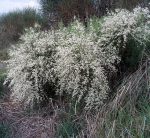 This deciduous flowering shrub is native to the Mediterranean region where it grows in coastal scrub often on sand dunes, and is a member of the pea family, Fabaceae, that also includes beans, lupines, and mimosa. Growing up to 10′ tall and 20′ wide, the bush has multiple slender gray-green weeping stems. The small leaves remain on the stems very briefly so the stems appears leafless most of the year. Short pendant racemes of white, pea-like flowers appear from mid winter to late spring, and are sweetly fragrant and attractive to bees and butterflies. Fruits are one seeded pods and seed production is prodigious. Plants are grown for use in medicine and in soil stabilization projects as well as ornamentals in areas with hot, dry summers and cool, moist winters. They are tolerant of drought and salt-laden winds, and can be used in seaside gardens. The flowers are good for preserving and drying. The genus name, Retama, is the Latinized form of the Arabic name for the plant, retem. The specific epithet, monosperma, is derived from the Greek words monos meaning one and spermus meaning seed, and refers to the one seeded fruit of the plant.
This deciduous flowering shrub is native to the Mediterranean region where it grows in coastal scrub often on sand dunes, and is a member of the pea family, Fabaceae, that also includes beans, lupines, and mimosa. Growing up to 10′ tall and 20′ wide, the bush has multiple slender gray-green weeping stems. The small leaves remain on the stems very briefly so the stems appears leafless most of the year. Short pendant racemes of white, pea-like flowers appear from mid winter to late spring, and are sweetly fragrant and attractive to bees and butterflies. Fruits are one seeded pods and seed production is prodigious. Plants are grown for use in medicine and in soil stabilization projects as well as ornamentals in areas with hot, dry summers and cool, moist winters. They are tolerant of drought and salt-laden winds, and can be used in seaside gardens. The flowers are good for preserving and drying. The genus name, Retama, is the Latinized form of the Arabic name for the plant, retem. The specific epithet, monosperma, is derived from the Greek words monos meaning one and spermus meaning seed, and refers to the one seeded fruit of the plant.
Type: Deciduous, flowering shrub
Outstanding Feature: Weeping form; flowers
Form: Weeping
Growth Rate: Rapid
Bloom:Small, pea-like white flowers
Size: 10′ H x 20′ W
Light: Full sun
Soil: Lean, dry, well-drained, especially in winter
Hardiness: Zones 9-11
Care: Can be invasive
Pests and Diseases:
Propagation:Scarified seed, half-ripe cuttings
Photo Credit: Wikipedia